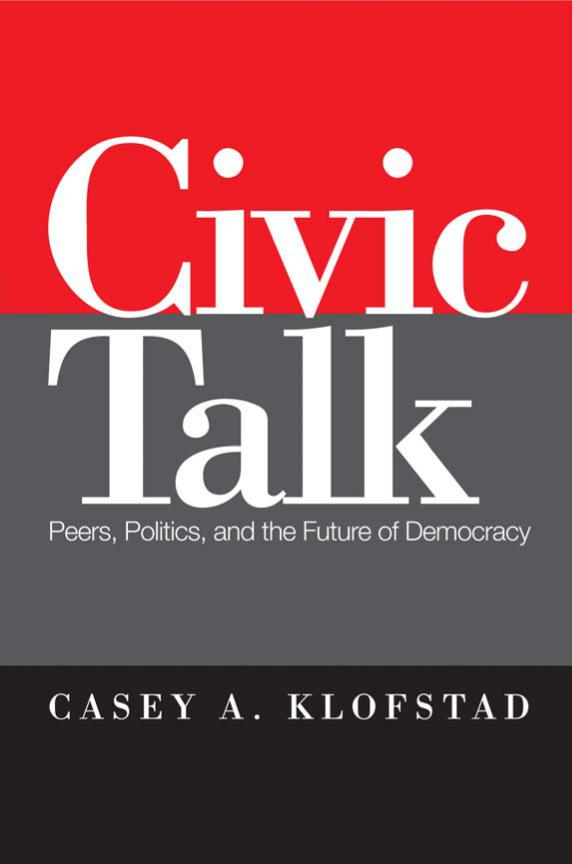

Civic Talk

In the series The Social Logic of Politics edited by Alan Zuckerman
Also in this series:
Alan S. Zuckerman, ed., The Social Logic of Politics: Personal Networks as Contexts for Political Behavior
James H. Fowler and Oleg Smirnov, Mandates, Parties, and Voters: How Elections Shape the Future
Simon Bornschier, Cleavage Politics and the Populist Right: The New Cultural Conflict in Western Europe

Casey A. Klofstad
Civic Talk
Peers, Politics, and the
Future of Democracy
TEMPLE UNIVERSITY PRESS
Philadelphia
TEMPLE UNIVERSITY PRESS
Philadelphia, Pennsylvania 19122
www.temple.edu/tempress
Copyright © 2011 Temple University
All rights reserved
Published 2011
Library of Congress Cataloging-in-Publication Data
Klofstad, Casey A. (Casey Andrew), 1976–
Civic talk : peers, politics, and the future of democracy / Casey A. Klofstad.
p.cm.
Includes bibliographical references and index. ISBN 978-1-4399-0272-1 (cloth : alk. paper) ISBN 978-1-4399-0274-5 (electronic)
1. Communication in politics—United States. 2 Communication—Political aspects—United States. 3. Political participation—United States. I. Title.
JA85.2.U6K56 2010 |
|
320.97301'4—dc22 |
2010018213 |
The paper used in this publication meets the requirements of the American National Standard for Information Sciences—Permanence of Paper for Printed Library Materials, ANSI Z39.48-1992
Printed in the United States of America
2 4 6 8 9 7 5 3 1
For Rindy

Contents
|
Preface |
ix |
|
Acknowledgments |
xi |
1 |
Introduction |
1 |
2 |
Civic Talk and Civic Participation |
11 |
3 |
Does Civic Talk Cause Civic Participation? |
29 |
4 |
Why Does Civic Talk Cause Civic Participation? |
51 |
5 |
Do You Matter? |
71 |
6 |
Do Your Peers Matter? |
91 |
7 |
The Significant and Lasting Effect of Civic Talk |
109 |
8 |
Peers, Politics, and the Future of Democracy |
127 |
|
APPENDIX A: The Collegiate Social Network Interaction |
|
|
Project (C-SNIP) |
143 |
|
APPENDIX B: C-SNIP Panel Survey Questions and Variables |
151 |
|
APPENDIX C: Matching Data Pre-processing |
161 |
|
References |
165 |
|
Index |
175 |

Preface
uring my first two years of graduate school, I became interested in Dthe sociological antecedents of public opinion and political behavior. At that time, the tools I had at my disposal to address this topic were publicly available survey data and a variety of methods of sta-
tistical analysis. Using these tools, I convinced myself that engaging in political discussion with friends, family, and other peers—what I call “civic talk”—led people to become more active in civil society. As soon as I had written my first paper on this subject, however, I was challenged in a research workshop with a number of indictments, such as “endogeneity,” “reciprocal causation,” and “selection bias.” In plain English, with survey data from one period in time, I was unable to show whether our peers influence our behavior or our patterns of behavior influence how we select and interact with our peers.
This experience left me wondering how I could possibly study a phenomenon that is shrouded in such deep analytical complexity. It was at that point that I took a step back from my research question and appealed to the simplest tenets of the scientific method. I had a hypothesis that civic talk causes civic participation. All I needed now was a way to test the hypothesis with an experiment. Ideally, to do this I would randomly assign people to new peer groups, some of whom engaged in civic talk and others of whom did not. Random assignment would ensure that any observed effects would be attributable to civic talk and not any other factor.
x |
Preface |
Unfortunately, unless you are the producer of a reality television show, this ideal research design is not feasible. As much as we may want to, we cannot simply pick a representative sample of individuals and randomly assign them to new social circles. So, instead, I found a situation in nature that approximated my ideal: I conducted a panel study of first-year college students who had been randomly assigned their dormitory roommates. I also conducted a series of focus groups to gain a richer qualitative understanding of civic talk and its effect on civic participation.
As the following pages show, these data give us an unprecedented level of confidence in the notion that civic talk has a meaningful and lasting effect on an individual’s patterns of civic participation. Given that citizens’ involvement in civil society is essential to the survival of democracy, this book shows that our peers have a critical role to play in maintaining this form of governance. Moreover, these results illustrate that extant theories of civic participation are incomplete because they focus on individual-level antecedents to the exclusion of sociological ones. Humans may not be Aristotelian political animals, but we certainly are social animals. This simple fact needs to be incorporated into our understanding and study of democracy.
